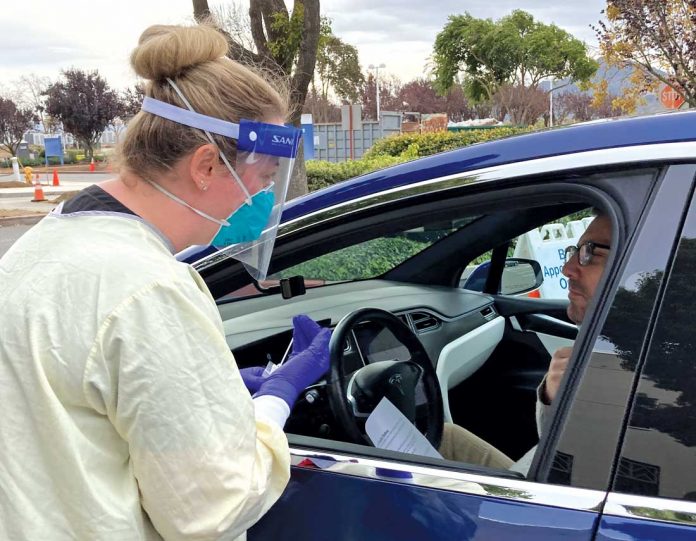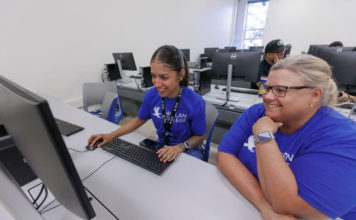
As the calendar flipped to Jan. 1, the prospect of 2020 was one filled with dreams of a fresh start and hope for the future, as the beginning of a new decade typically brings.
The term “novel coronavirus” had not yet become part of the vocabulary of most Americans, as it seemed a distant reality that an outbreak thought to have originated in a market in Wuhan, China would reach our shores.
Just a year ago, most of us had never heard of “social distancing,” “Zoom meeting,” “contact tracing” or “purple tier.” Today, however, these define our everyday lives, down to the smallest details and activities.
As 2020 draws to a close, we look back at the moments in the pandemic that brought us to where we are now.
Shelter in place
Locally, the Covid-19 pandemic changed almost everybody’s lives overnight on March 17, the date that Santa Clara County Public Health Officer Dr. Sara Cody and six of her colleagues in the Bay Area enacted the first countywide shelter-in-place order.
Immediately, permitted activities were defined as “essential” and “non-essential.”
Retail stores, restaurants, gyms, entertainment venues and hair salons closed—some never to reopen—leaving thousands of South County residents unemployed. By April—after state officials and other counties issued further stay-home directives—more than 4 million residents of California had applied for unemployment benefits.
The pandemic and related shutdowns cut the school year short, sending students home to complete their classes online and graduating seniors to participate in virtual commencement celebrations. Most schools in Santa Clara County still have not reopened, though Morgan Hill Unified School District has begun a pilot program to bring students back to some classrooms with a hybrid remote/in-person model.
In the months that followed the initial shelter-in-place order, county and state officials scrambled through new, emergency pandemic enforcement regimes as they allowed some industries to slowly reopen in a delicate effort to balance economic activity with the rate of Covid-19’s spread.
Since the summertime, face coverings have been required in public settings. Certified Covid-19 protocol checkmarks are posted on the front door of every business that remains open, indicating they are in compliance with social distancing guidelines.
Portable tents, canopies and shade structures that restaurants erected in their parking spaces and other outdoor areas—lining downtown streets in Morgan Hill, Gilroy and cities throughout the Bay Area—now sit empty, as not even outdoor dining is allowed in Santa Clara and surrounding counties. The Bay Area remains in what the state has dubbed the “purple tier”—in the governor’s latest version of the Covid-19 reopening blueprint—and back to the tightest restrictions on public and business activities that were imposed as of March 17.
The current stay-at-home order is set to expire Jan. 4, though state and county officials may extend that date as Covid-19 continues to spread, with South County as a hotspot.
Covid-19 reaches Gilroy
As Covid-19 worries began to grow in early March, Gilroyans began to wonder when the virus would reach the city.
During his monthly “Conversation and Coffee with the Mayor” on March 7, then-Mayor Roland Velasco shared the news that everyone had anticipated: A Gilroy man had tested positive for Covid-19.
Within hours of the post on gilroydispatch.com and the Dispatch Facebook page, the initial news went viral, with nearly 1,000 shares on social media and more than 25,000 views of the story online.
“Let’s be smart about this, let’s not panic,” Velasco told the small audience attending the event. “We have to be reasonable, we have to be respectful.”
However, the next day, the Centers for Disease Control and Prevention and county health officials confirmed that the man had tested negative.
But it wasn’t long after that the first confirmed cases were announced.
On March 15, an 80-year-old Gilroy woman was the city’s first confirmed Covid-19 death and the second county fatality tied to the virus.
The second Gilroy death was a man in his 60s, who was hospitalized on March 5 and died on March 17, according to a health department statement.
Transition to virtual life
Public gatherings have been strictly prohibited since March, forcing local promoters to cancel the Gilroy Garlic Festival, Morgan Hill Mushroom Mardi Gras, Friday Night Music Series, Independence Day festivities and countless other events.
Some of these event organizers pivoted to online, virtual festivities, including recorded cooking demonstrations for the Garlic Festival and a virtual parade in place of Morgan Hill’s traditional Fourth of July procession.
These event producers have not yet announced plans for 2021.
Public meetings have occurred almost exclusively by Zoom and other videoconferencing apps in Morgan Hill, Gilroy and at the Santa Clara County Board of Supervisors. Residents who once commuted hours to and from work every day have used the same technology to work primarily from home since the pandemic started.
The pandemic and related shutdowns also cut the school year short, sending students home to complete their classes online and graduating seniors to participate in virtual commencement celebrations.
City, businesses cut staff
The pandemic forced the City of Gilroy to trim its workforce in 2020.
A total of 45 positions were cut, 14 of which were vacant. In addition, most part-time staff were furloughed, with the recreation department being one of the hardest hit departments in the city.
With the Covid-19 health emergency slashing a significant portion of the city’s revenue streams, mainly sales tax and transient occupancy tax, Gilroy was faced with an $8 million shortfall over the next two years had layoffs not been enacted, City Administrator Jimmy Forbis told the Gilroy City Council in June.
During his presentation, Forbis said there was “no joy” in presenting the cuts.
“I wish there was something I could say that would put a positive spin on things and make things not seem as bad as they are, but this is not the world that we are in right now,” he said.
Faced with restrictions and forced closures brought on by the shelter-in-place order in March and its subsequent revisions, many Gilroy businesses either cut staff or permanently shut their doors, including longtime downtown establishments Gilroy Bowl and Scotty’s Restaurant and Collective Past.
Early in the pandemic, at least 177 employees were laid off at the Gilroy Premium Outlets, according to state filings, as the shopping center of nearly 120 stores was shut down for nearly three months.
Vaccine arrives
In mid-December, health officials described a “light at the end of the tunnel” when the first shipment of the Pfizer-BioNTech Covid-19 vaccine arrived in Santa Clara County.
A total of 17,550 doses of the Pfizer vaccine have been allocated to Santa Clara County, with frontline medical workers and residents and staff at skilled nursing facilities the first in line to receive the virus safeguard injection.
Covid-19 vaccines produced by Pfizer and Moderna were approved by U.S. regulators in early December. Santa Clara County has been allocated 39,300 doses of the Moderna vaccine.
In a small ceremony held in the Saint Louise Regional Hospital lobby, Dr. Roger Chiou became the first in South County to receive the vaccine on Dec. 17.
Despite the vaccines, health officials say it will be many months before there will be a noticeable effect on the rising tide of infections, and county Public Health Officer Dr. Sara Cody told the Board of Supervisors that there are “very dark days ahead.”
Distribution of the vaccine will follow the requirements from the federal and state governments, which set the sequence for groups to receive the vaccine. The county expects to soon receive additional information from the state about future vaccine allocation, distributions, requirements and timelines.
Grim milestone reached
Dr. Sara Cody, who has remained steadfast through the rapidly changing nature of the pandemic throughout the year, was moved to tears on Dec. 15 when she announced that Santa Clara County had surpassed 50,000 cases and 550 deaths.
“Our pandemic here locally is out of control, and our healthcare system is beyond stretched,” she told the Board of Supervisors. “It’s become pretty clear that we do need to take more serious action. We are truly, truly in the worst place we have ever been in this pandemic and by a very large margin.”
The numbers would only get worse. On Dec. 23, officials announced that Covid-19 was the third leading cause of death in the county, behind cancer and heart disease.
In mid-November—a week before Thanksgiving—an average of three people died per day due to Covid-19, according to county staff. A month later, that average increased to nearly six people per day. The county’s seven-day average positivity rate as of Dec. 13 was 7.7 percent, the highest since the pandemic began in March.
As of Dec. 28, 652 people have died.
Michael Moore contributed to this report.














